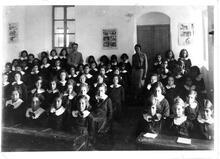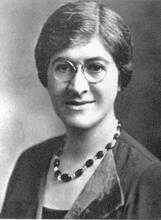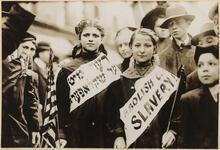Rivke Savich Golomb
Rivke Savich Golomb was an educator and Yiddishist who taught at Jewish schools in Warsaw, Palestine, Canada, and Mexico over the course of her career. Born in Vilna, she decided to become a teacher of Jewish studies after World War I. In 1929 she met and married Abraham Golomb. The newlyweds immigrated to Palestine, but after realizing Yiddish had no future there, they immigrated to Canada in 1939. Five years later they were invited to Mexico. Rivke became a teacher at and Abraham became the principal of Colegio Israelit de Mexico. After the Golombs were attacked for their anti-Zionism, they established Nuevo Colegia Israelita I. L Peretz. The school’s philosophy was “golombist” in that it saw Yiddishkait not as a religion but as humanism in a Jewish world.
“Golombism,” Rivke and Abraham Golomb’s ideology, came to the fore in Jewish education in Mexico with the founding of El Nuevo Colegio Israelita de Mexico I. L Peretz in 1950. The couple had many followers not only in Mexico but also in Europe, Israel and Canada. In 1946 they founded the Seminar le-Morim (Teachers’ Seminar) where they taught the first generations of teachers in Jewish education in Mexico. Rivke Golomb taught practical pedagogy and “geshikhte fun yidisher dertsiung” (History of Jewish Education).
Family & Education
Rivke Savich, second of four children, was probably born in a village near Vilna on May 5, 1905. Her mother died in a typhus epidemic when Rivke was only fifteen. Her father, Yosef Savich, a farmer, fought in the Tsar’s army against the Japanese (1904–1905) and his loyalty to the country led him to participate in World War I, when he was taken prisoner by the Germans.
Rivke’s early studies were in a heder, where she was the only girl pupil. Her “rebbe” urged her to seek out new knowledge everywhere, “to study with pleasure and to search for the divine.” She later alleged that if she was able to achieve anything in education it was because the “rebbe,” her first teacher, was an extraordinary pedagogue. Her formal studies were at a German school in Vilna. At the end of World War I she decided to become a teacher of Jewish studies and indeed dedicated her entire life to this task. In 1927 she studied at the Yidisher Lehrer Seminar in Vilna and after matriculating from the seminary taught for one year in Warsaw. It was at the seminary that she met the principal, Abraham Golomb (1885-1982), whom she married in 1929. Their only son, Berl, was born in 1930.
Palestine, Canada, & Mexico
As newlyweds the Golombs emigrated to Palestine where Rivke taught from 1931 to 1932 at Mikve Israel and from 1933 to 1939 in the Ben Shemen Youth Village. During this time she published articles in Em ve-Yeled (Mother and Child). When the Golombs realized that Yiddish had no future in Palestine they decided to go to Winnipeg (Canada) where they were invited to establish a school. Rivke taught from 1939 to 1944 at the I. L. Peretz School while also participating in community activities.
Abraham’s international reputation as a Yiddishist educator led to the couple’s being invited to Mexico, where Abraham Golomb served from 1944 to 1949 as principal of the Colegio Israelita de Mexico, Mexico City’s first private and secular Jewish educational institution, founded in 1924. Rivke became a teacher at the school.
Abraham Golomb’s fanatical advocacy of Yiddish and his somewhat bellicose nature led him into numerous conflicts with those who did not share his views. He even went so far in his anti-Zionism as to forbid Keren Kayemet (Jewish National Fund) collection boxes to be brought into the school on the grounds that “education should not have any taint of politics.” Rivke, who always supported him, argued that zedakah (charity) should be taught as a A biblical or rabbinic commandment; also, a good deed.mitzvah, but that no political party should be its beneficiary.
Educational Philosophy
In January 1959, following a campaign against the Golombs, members of the parents’ association and a number of teachers and intellectuals who published regularly in Di Shtime and Der Veg decided to establish another school, the Nuevo Colegio Israelita I. L. Peretz. The Nuevo Colegio determined that the “golombist” philosophy of integration—Yidishkait not as a religion but as humanism in a Jewish world—would become the keynote of the new school, where Yiddish and (Ashkenazi) Hebrew, Jewish history, ethics and respect for Israel and Mexico would be taught, together with the subjects demanded by the Mexican government. Ironically, from the time of its founding there was always a Keren Kayemet box in the school. Two years after the establishment of the state of Israel, the Golombs accepted the new reality and perceived helping Israel as only natural.
Rivke was a woman of strong character, a perfectionist, with progressive and liberal ideas. Her wide knowledge of world culture, especially Greek literature, inspired her educational philosophy. She worked mainly with young children, with friendship and love, maintaining that “education was an art.” She taught her pupils to think rather than to memorize and made as deep an impression on them as her teachers had made on her. In her view, a good teacher “communicates ideas, awakens sentiments, develops a love for beauty and harmony and stimulates her pupils so that later on in life they can give something back to their people’s country and thus to general culture.”
End of Life & Legacy
After thirteen years as principal, Abraham Golomb decided to hand his post over to his wife. This decision led to a strike by those who saw this as an act of nepotism. It is noteworthy that there had never before been any women principals. In the face of this reaction Rivke Golomb decided to bow out and the couple migrated once again, this time to Los Angeles, California.
Ten years later Rivke suffered a stroke which left her a paraplegic. After her husband’s death in 1982 she survived for another five years, making heroic efforts to walk and be self-sufficient. She died in Los Angeles in 1987.
In an effort to perpetuate their legacy in Mexico, Rivke established the Abraham Golomb Foundation, which awards a prize to those who dedicate themselves to ensuring the survival of Yiddish as a language and a culture.
Finkelman de Sommer, Maty. “Instruye a tus hijos.” In Generaciones judías en México. Kehila Ashkenazi (1922–1992), Alice G. Backal (coord.). México: D.F. Comunidad Ashkenazi de México, 1993.
Zabludowsky, Vele. Interview with Naty G. de Okon, August 1988. In Testimonios de la Historia Oral. Judíos en México. Avni, Haim (dir.) UHJ y Amigos UHJ. México: Asociación Mexicana de Amigos de la Universidad Hebrea de Jerusalén, 1990.
Torenberg, Jaya. Interview with Naty G. de Okon, July 1989. In Testimonios de la Historia Oral. Judíos en México. México: Asociación Mexicana de Amigos de la Universidad Hebrea de Jerusalén, 1990.
Golomb, Berl. Interview and notes about his mother, September 2002.
Golomb, Rivke. “Al het shejetanu” (Yiddish). Naye Yidishe Shule Vol. 9. Mexico (October 1958).
Golomb, Rivke. “Lerer” (Yiddish). Naye Yidishe Shule 14 (México): October 1963.
Grapa, Frida. Interview with the author, México D.F. (September 2002).
Cimet, Shoshana. Interview and Rivke Golomb personal letters, México D. F. (2002).











